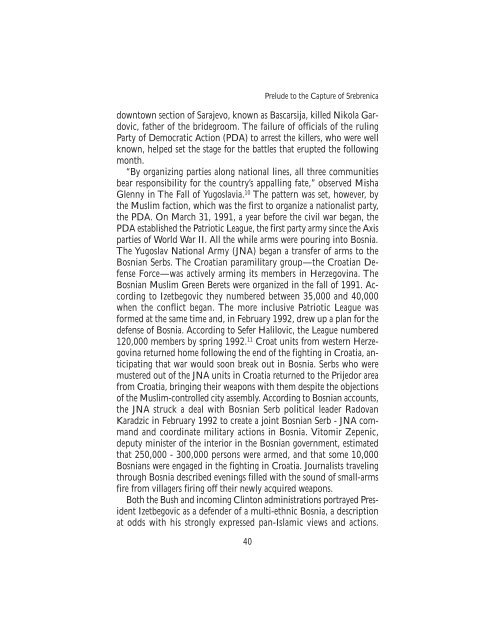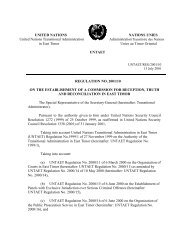The Srebrenica Massacre - Nova Srpska Politicka Misao
The Srebrenica Massacre - Nova Srpska Politicka Misao
The Srebrenica Massacre - Nova Srpska Politicka Misao
Create successful ePaper yourself
Turn your PDF publications into a flip-book with our unique Google optimized e-Paper software.
Prelude to the Capture of <strong>Srebrenica</strong><br />
downtown section of Sarajevo, known as Bascarsija, killed Nikola Gardovic,<br />
father of the bridegroom. <strong>The</strong> failure of officials of the ruling<br />
Party of Democratic Action (PDA) to arrest the killers, who were well<br />
known, helped set the stage for the battles that erupted the following<br />
month.<br />
“By organizing parties along national lines, all three communities<br />
bear responsibility for the country’s appalling fate,” observed Misha<br />
Glenny in <strong>The</strong> Fall of Yugoslavia. 10 <strong>The</strong> pattern was set, however, by<br />
the Muslim faction, which was the first to organize a nationalist party,<br />
the PDA. On March 31, 1991, a year before the civil war began, the<br />
PDA established the Patriotic League, the first party army since the Axis<br />
parties of World War II. All the while arms were pouring into Bosnia.<br />
<strong>The</strong> Yugoslav National Army (JNA) began a transfer of arms to the<br />
Bosnian Serbs. <strong>The</strong> Croatian paramilitary group—the Croatian Defense<br />
Force—was actively arming its members in Herzegovina. <strong>The</strong><br />
Bosnian Muslim Green Berets were organized in the fall of 1991. According<br />
to Izetbegovic they numbered between 35,000 and 40,000<br />
when the conflict began. <strong>The</strong> more inclusive Patriotic League was<br />
formed at the same time and, in February 1992, drew up a plan for the<br />
defense of Bosnia. According to Sefer Halilovic, the League numbered<br />
120,000 members by spring 1992. 11 Croat units from western Herzegovina<br />
returned home following the end of the fighting in Croatia, anticipating<br />
that war would soon break out in Bosnia. Serbs who were<br />
mustered out of the JNA units in Croatia returned to the Prijedor area<br />
from Croatia, bringing their weapons with them despite the objections<br />
of the Muslim-controlled city assembly. According to Bosnian accounts,<br />
the JNA struck a deal with Bosnian Serb political leader Radovan<br />
Karadzic in February 1992 to create a joint Bosnian Serb - JNA command<br />
and coordinate military actions in Bosnia. Vitomir Zepenic,<br />
deputy minister of the interior in the Bosnian government, estimated<br />
that 250,000 - 300,000 persons were armed, and that some 10,000<br />
Bosnians were engaged in the fighting in Croatia. Journalists traveling<br />
through Bosnia described evenings filled with the sound of small-arms<br />
fire from villagers firing off their newly acquired weapons.<br />
Both the Bush and incoming Clinton administrations portrayed President<br />
Izetbegovic as a defender of a multi-ethnic Bosnia, a description<br />
at odds with his strongly expressed pan-Islamic views and actions.<br />
40



